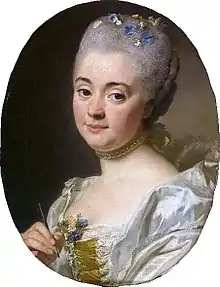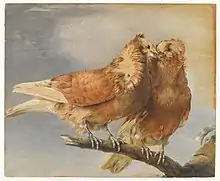Marie-Thérèse Reboul
Marie-Thérèse Reboul (26 February 1735—4 January 1806),[1][2] commonly called Madame Vien,[3] was a French painter and engraver of natural history subjects, still lifes, and flowers.
Marie-Thérèse Reboul-Vien | |
|---|---|
 Marie-Thérèse Reboul-Vien (1757) by Alexander Roslin | |
| Born | 26 February 1735 Paris, France |
| Died | 4 July 1806 (aged 71) Paris, France |
| Nationality | French |
| Known for | Painting, engraving |
| Notable work | Two Pigeons on a Tree Branch (1762) |
| Spouse | |
In 1757, Marie-Thérèse Reboul married the painter Joseph-Marie Vien, who was nineteen years older.[2][3] Nineteenth-century sources state that she was taught by her husband,[4][5] but Joseph-Marie Vien's autobiography does not mention it.[3] She may have been a student of Madeleine Françoise Basseporte.[6] Prior to her marriage, Reboul-Vien engraved specimens for Sénégal: Coquillages (1757) by the French naturalist Michel Adanson and Dissertation sur le papyrus (1758) by the French antiquarian Anne Claude de Caylus.[3]

Reboul-Vien was one of only fifteen women to be accepted as full academicians in the 145-year history of the Académie royale de peinture et de sculpture in Paris.[5] She was admitted in 1757, the same year in which she married Joseph-Marie Vien. It had been 37 years since the last woman, Rosalba Carriera, became an academician.[3] Reboul-Vien's husband was a prominent member of the Académie, which likely led to her acceptance.[7] At the time, Reboul-Vien was described as "a painter of miniatures and gouaches specializing in flowers, butterflies and birds."[6] Her reception piece was Two Pigeons Pigeons on a Tree Branch, which she submitted to the Académie in 1762.[8]
She exhibited her works at the Salons of 1757, 1759, 1763, 1765, and 1767.[9] These included watercolors of a hen with her chicks, a kestrel killing a small bird, a golden pheasant from China, a brooding pigeon, and a bird of prey following a butterfly.[4] At the Salon of 1767, Denis Diderot praised A Crested Hen Watching over Her Chicks as a "very handsome small painting" that was "painted with great vigor and coloristic truth ... Everything's right, including the bits of straw scattered around the hen."[10] He concluded, more critically, "I'm surprised by her hen; I didn't think she was this accomplished."[10] Even so, reviews of Reboul-Vien's works were mostly positive.[3] Several of her works were acquired by Catherine the Great.[4] By the late the nineteenth century, few of her watercolors could be located.[5]
References
- Thieme, Ulrich; Becker, Felix, eds. (1940). Allgemeines Lexikon der bildenden Künstler von der Antike bis zur Gegenwart. Vol. 34. Leipzig: E.A. Seemann. p. 338.
- Jal, Augustin (1867). Dictionnaire critique de biographie et d'histoire. Paris: Henri Plon. pp. 1265–1266.
- Hottle, Andrew D. (2014). "Present but Absent: The Art and Life of Madame Vien". Southeastern College Art Conference Review. 16 (4): 424–442.
- Gabet, Charles Henri Joseph (1854). "Vien (Mme. Marie Reboul)". Dictionnaire des artistes de l'ecole française, au XIXe siècle. Paris: Chez Madame Vergne, Libraire. p. 690.
- Fidière, Octave (1885). Les Femmes artistes à l'Académie royale de peinture et de sculpture. Paris: Charavay Frères. pp. 27–31.
- Pomeroy, Jordana, ed. (2012). Royalists to Romantics: Women Artists from the Louvre, Versailles, and Other French National Collections. Washington, DC: National Museum of Women in the Arts. p. 120.
- Harris, Ann Sutherland; Nochlin, Linda (1976). Women Artists, 1550–1950. Los Angeles: Los Angeles County Museum of Art. p. 36.
- Rosenberg, Pierre, ed. (2000). Les peintres du roi, 1648-1793. Réunion des Musées Nationaux.
- Seznec, Jean; Adhémar, Jean, eds. (1957). Diderot: Salons, 1759-1781. Oxford: Clarendon Press.
- Diderot on Art, Volume II: The Salon of 1767. Translated by John Goodman. New Haven: Yale University Press. 1995. p. 136.